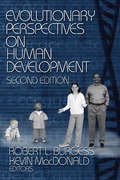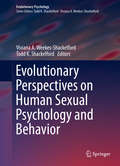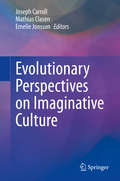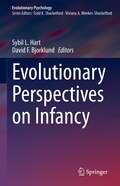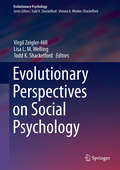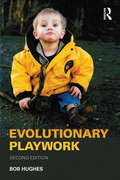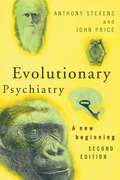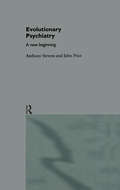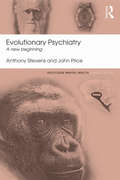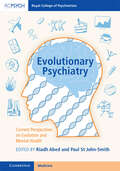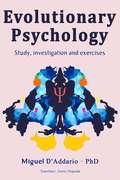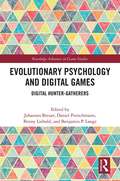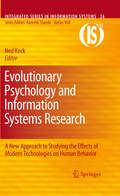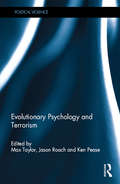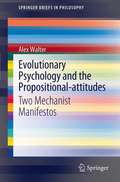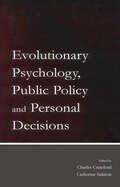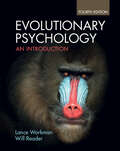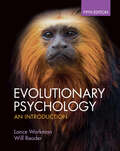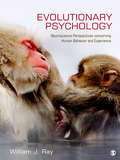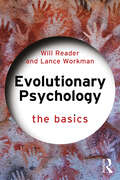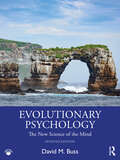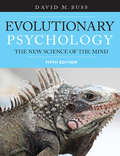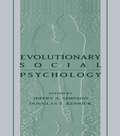- Table View
- List View
Evolutionary Perspectives on Human Development
by Robert Lee Burgess Kevin MacDonaldEvolutionary Perspectives on Human Development, Second Edition considers the role of evolutionary theory in the field of developmental psychology to examine key topics of individual human development. This unique book fills an important gap in the literature, applying evolutionary models to human development by focusing on central development issues. The book emphasizes both domain-general evolved psychological mechanisms and domain-specific processes. The text also integrates behavior-genetic research with evolutionary and developmental principles. Evolutionary Perspectives on Human Development provides state-of-the-art groundwork in evolutionary theory as viewed by leading thinkers in the field.
Evolutionary Perspectives on Human Sexual Psychology and Behavior
by Todd K. Shackelford Viviana A. Weekes-ShackelfordThis volume in the Springer Series in Evolutionary Psychology presents a state of the art view of the topic of sexuality and sexual behavior drawing on theoretical constructs and research of noted individuals in the field. Comprehensive and multi-disciplinary, this book seeks to provide a broad overview without sacrificing the complexity of a multi-faceted approach. The book is framed by introductory and closing sections that provide a context for the range of ideas contained within. Ample space is provided in designated sections that focus on key areas of sexuality from both male and female perspectives and that include information from primate studies. This volume can serve as a graduate text in sexual behavior in evolutionary terms and as a guide for further research.
Evolutionary Perspectives on Imaginative Culture
by Joseph Carroll Mathias Clasen Emelie JonssonThis pioneering volume offers an expansive introduction to the relatively new field of evolutionary studies in imaginative culture. Contributors from psychology, neuroscience, anthropology, and the humanities probe the evolved human imagination and its artefacts. The book forcefully demonstrates that imagination is part of human nature. Contributors explore imaginative culture in seven main areas:Imagination: Evolution, Mechanisms and FunctionsMyth and ReligionAesthetic TheoryMusicVisual and Plastic ArtsVideo Games and FilmsOral Narratives and LiteratureEvolutionary Perspectives on Imaginative Culture widens the scope of evolutionary cultural theory to include much of what “culture” means in common usage. The contributors aim to convince scholars in both the humanities and the evolutionary human sciences that biology and imaginative culture are intimately intertwined. The contributors illuminate this broad theoretical argument with comprehensive insights into religion, ideology, personal identity, and many particular works of art, music, literature, film, and digital media.The chapters “Imagination, the Brain’s Default Mode Network, and Imaginative Verbal Artifacts” and “The Role of Aesthetic Style in Alleviating Anxiety About the Future” are licensed under the terms of the Creative Commons Attribution 4.0 International License (http://creativecommons.org/licenses/by/4.0/).
Evolutionary Perspectives on Infancy (Evolutionary Psychology)
by Sybil L. Hart David F. BjorklundThis unique volume is one of the first of its kind to examine infancy through an evolutionary lens, identifying infancy as a discrete stage during which particular types of adaptations arose as a consequence of certain environmental pressures. Infancy is a crucial time period in psychological development, and evolutionary psychologists are increasingly recognizing that natural selection has operated on all stages of development, not just adulthood. The volume addresses this crucial change in perspective by highlighting research across diverse disciplines including developmental psychology, evolutionary developmental psychology, anthropology, sociology, nutrition, and primatology. Chapters are grouped into four sections:Theoretical UnderpinningsBrain and Cognitive DevelopmentSocial/Emotional DevelopmentLife and DeathEvolutionary Perspectives on Infancy sheds new light on our understanding of the human brain and the environments responsible for shaping the brain during early stages of development. This book will be of interest to evolutionary psychologists and developmental psychologists, biologists, and anthropologists, as well as scholars more broadly interested in infancy.
Evolutionary Perspectives on Social Psychology
by Todd K. Shackelford Virgil Zeigler-Hill Lisa L. M. WellingThis wide-ranging collection demonstrates the continuing impact of evolutionary thinking on social psychology research. This perspective is explored in the larger context of social psychology, which is divisible into several major areas including social cognition, the self, attitudes and attitude change, interpersonal processes, mating and relationships, violence and aggression, health and psychological adjustment, and individual differences. Within these domains, chapters offer evolutionary insights into salient topics such as social identity, prosocial behavior, conformity, feminism, cyberpsychology, and war. Together, these authors make a rigorous argument for the further integration of the two diverse and sometimes conflicting disciplines. Among the topics covered: How social psychology can be more cognitive without being less social. How the self-esteem system functions to resolve important interpersonal dilemmas. Shared interests of social psychology and cultural evolution. The evolution of stereotypes. An adaptive socio-ecological perspective on social competition and bullying. Evolutionary game theory and personality. Evolutionary Perspectives on Social Psychology has much to offer students and faculty in both fields as well as evolutionary scientists outside of psychology. This volume can be used as a primary text in graduate courses and as a supplementary text in various upper-level undergraduate courses.
Evolutionary Playwork
by Bob HughesPlay is a crucial component in the development of all children. In this fully updated and revised edition of his classic playwork text, Bob Hughes explores the complexities of children’s play, its meaning and purpose, and argues that adult-free play is essential for the psychological well-being of the child. The book is divided into fourteen chapters that together examine the fundamentals of evolutionary play. Firstly, Hughes examines the very earliest ideas of playwork and its impact on brain growth and organization today. He then goes on to explore and explain the key theoretical concepts underlying playwork. These include discussions on free play and creating suitable play environments alongside more thorny issues such as safety and consultation. Finally, the book offers up some of Hughes’ most recent research that reveals how his approach to play and playwork in global society has continued to evolve throughout his career to meet new challenges and needs. Throughout this book, Hughes has included his fellow practitioner Mick Conway’s vivid observations of children at play to bring the facts and arguments in the text to life. This revised edition reflects important recent advances in our understanding of the evolutionary history of play and its impact on the development of the brain, of the role play in the development of resilience and of the impact of play deprivation. Evolutionary Playwork is still the only book to combine the reality of playwork practice with the fundamentals of evolutionary and developmental psychology, and it is still essential reading for all playwork students, practitioners and researchers.
Evolutionary Psychiatry, second edition: A New Beginning (Routledge Mental Health Classic Editions Ser.)
by Anthony Stevens John PriceChallenging a medical model which has supplied few effective answers to long-standing conundrums, Evolutionary Psychiatry proposes a new conceptual framework for psychiatry based on Darwinian theory. Anthony Stevens and John Price argue that psychiatric symptoms are manifestations of ancient adaptive strategies which are no longer necessarily appropriate but which can best be understood and treated in an evolutionary and developmental context. They propose theories to account for the widespread existence of affective disorders, borderline states and schizophrenia, as well as offering solutions for puzzles such as sadomasochism and the function of dreams. This comprehensive introduction to the new science of Darwinian Psychiatry is readily accessible to both the specialist and non-specialist reader. It describes in detail the disorders and conditions commonly encountered in psychiatric practice and show how evolutionary theory can account for their biological origins and functional nature.
Evolutionary Psychiatry: A New Beginning
by Anthony Stevens John PriceEvolutionary Psychiatry was first published in 1996, the second edition followed in 2000. This ground breaking book challenged the medical model which supplied few effective answers to long-standing conundrums. A comprehensive introduction to the science of Darwinian Psychiatry, the second edition included important fresh material on a number of disorders, along with a chapter on research. Anthony Stevens and John Price argue that psychiatric symptoms are manifestations of ancient adaptive strategies which are no longer necessarily appropriate but which can best be understood and treated in an evolutionary and developmental context. Particularly important are the theories Stevens and Price propose to account for the worldwide existence of mood disorders and schizophrenia, as well as offering solutions for such puzzles as paedophilia, sado-masochism and the function of dreams. Readily accessible to both the specialist and non-specialist reader, Evolutionary Psychiatry describes in detail the disorders and conditions commonly encountered in psychiatric practice and shows how evolutionary theory can account for their biological origins and functional nature.
Evolutionary Psychiatry: A new beginning (Routledge Mental Health Classic Editions)
by Anthony Stevens John PriceEvolutionary Psychiatry was first published in 1996, the second edition followed in 2000. This ground breaking book challenged the medical model which supplied few effective answers to long-standing conundrums. A comprehensive introduction to the science of Darwinian Psychiatry, the second edition included important fresh material on a number of disorders, along with a chapter on research. Anthony Stevens and John Price argue that psychiatric symptoms are manifestations of ancient adaptive strategies which are no longer necessarily appropriate but which can best be understood and treated in an evolutionary and developmental context. Particularly important are the theories Stevens and Price propose to account for the worldwide existence of mood disorders and schizophrenia, as well as offering solutions for such puzzles as paedophilia, sado-masochism and the function of dreams. Readily accessible to both the specialist and non-specialist reader, Evolutionary Psychiatry describes in detail the disorders and conditions commonly encountered in psychiatric practice and shows how evolutionary theory can account for their biological origins and functional nature. This Classic Edition of the book includes a new preface by Anthony Stevens and a foreword by Paul Gilbert.
Evolutionary Psychiatry: Current Perspectives on Evolution and Mental Health
by Riadh Abed St John-Smith, PaulEvolutionary psychiatry attempts to explain and examine the development and prevalence of psychiatric disorders through the lens of evolutionary and adaptationist theories. In this edited volume, leading international evolutionary scholars present a variety of Darwinian perspectives that will encourage readers to consider 'why' as well as 'how' mental disorders arise. Using insights from comparative animal evolution, ethology, anthropology, culture, philosophy and other humanities, evolutionary thinking helps us to re-evaluate psychiatric epidemiology, genetics, biochemistry and psychology. It seeks explanations for persistent heritable traits shaped by selection and other evolutionary processes, and reviews traits and disorders using phylogenetic history and insights from the neurosciences as well as the effects of the modern environment. By bridging the gap between social and biological approaches to psychiatry, and encouraging bringing the evolutionary perspective into mainstream psychiatry, this book will help to inspire new avenues of research into the causation and treatment of mental disorders.
Evolutionary Psychology
by Miguel D'AddarioDifferent institutions, theories and psychological systems have focused their endeavors in different areas, existing from the focuses that are centered solely in the observable behavior. (behaviorism), by passing through those which occupy internal processes such as the thought, the reasoning, the memory, etc.
Evolutionary Psychology and Digital Games: Digital Hunter-Gatherers (Routledge Advances in Game Studies)
by Johannes Breuer Daniel Pietschmann Benny Liebold Benjamin P. LangeEvolutionary Psychology and Digital Games: Digital Hunter-Gatherers is the first edited volume that systematically applies evolutionary psychology to the study of the use and effects of digital games. The book is divided into four parts: Theories and Methods Emotion and Morality Social Interaction Learning and Motivation These topics reflect the main areas of digital games research as well as some of the basic categories of psychological research. The book is meant as a resource for researchers and graduate students in psychology, anthropology, media studies and communication as well as video game designers who are interested in learning more about the evolutionary roots of player behaviors and experiences.
Evolutionary Psychology and Information Systems Research
by Ned KockThe point of Information System (IS) EP research then is that these evolved psychological traits very likely influence our behavior toward modern technologies, and a deeper understanding of how technology affects behavior might be achieved by applying concepts and theories from EP. Springer author Ned Kock (Information Systems Action Research: An Applied View of Emerging Concepts and Methods) is probably the leading scholar in IS-EP research, and he is proposing an AoIS volume to gather together for the first time invited papers on EP concepts and theories that can be used as a basis for future research; examples of ongoing IS-EP research; and a look at the current debate on IS-EP research. Kock will invite leading scholars in IS and IS-EP research as well as the leading scholars in pure EP (see attached proposal for all names) to contribute papers. Topics to be covered include basic human behavior toward technology; interface design; online dating and consumer behavior; information search and use behavior; and autopoiesis and self-organizing information systems.
Evolutionary Psychology and Terrorism (Political Violence)
by Ken Pease Jason Roach Max TaylorThis book explores the evolutionary context of terrorism and political violence. While evolutionary thinking has come to permeate both biological and social-science theorising, it has not yet been applied systematically to the areas of terrorism and political violence. This volume seeks to do this for the first time. It presents a collection of essays on evolutionary psychology and terrorism, which encourage the reader to approach terrorism from a non-traditional perspective, by developing new approaches to understanding it and those who commit such acts of violence. The book identifies evolutionary thought as heuristically important in the understanding of terrorism, explores the key conceptual themes, and provides an evolutionary (and cross-species) understanding of the community-wide effects of terrorist attacks. The contributors bring forward innovative ideas and concepts to assist the practitioner, analyst and academic to better understand and respond to the threat of terrorism. In doing so this book challenges existing assumptions about terrorism and those who carry out such acts, in order to move the debate into new areas characterized by an emphasis on intellectual quality and rigour, an interdisciplinary approach, and a drawing together of theory and practice. The intention is to provide a sufficient discussion to enable the reader to both understand the relevance of evolutionary thinking to terrorism and political violence, and to appreciate the practical implications of conceptualising problems in this way. This book will be of much interest to students of terrorism and political violence, psychology, criminology and security studies.
Evolutionary Psychology and the Propositional-attitudes
by Alex WalterThe two essays provide a critical examination of theory and research in the field of evolutionary psychology. The view advanced here is that philosophical materialism and minimalist assumptions about adaptation serve Darwinian psychology better than the more popular alternative view that relies on cognitive dualism and propositional-attitude psychology to formulate evolutionary psychology theory. A commitment to cognitive dualism is destined to undermine the physical basis of behavior upon which evolutionary theory depends. Many evolutionary psychologists do not see this but are seduced by the easy way in which hypotheses can be formulated using the 'propositional-attitude' model. The challenge is to develop a materialistic and mechanistic approach to understanding human cognition and behavior, including linguistic and social behavior.
Evolutionary Psychology and the Propositional-attitudes: Two Mechanist Manifestos (SpringerBriefs in Philosophy)
by Alex WalterThe two essays provide a critical examination of theory and research in the field of evolutionary psychology. The view advanced here is that philosophical materialism and minimalist assumptions about adaptation serve Darwinian psychology better than the more popular alternative view that relies on cognitive dualism and propositional-attitude psychology to formulate evolutionary psychology theory. A commitment to cognitive dualism is destined to undermine the physical basis of behavior upon which evolutionary theory depends. Many evolutionary psychologists do not see this but are seduced by the easy way in which hypotheses can be formulated using the ‘propositional-attitude’ model. The challenge is to develop a materialistic and mechanistic approach to understanding human cognition and behavior, including linguistic and social behavior.
Evolutionary Psychology, Public Policy and Personal Decisions
by Charles Crawford Catherine SalmonDuring the last 15 years, human sociobiology has metamorphosed into evolutionary psychology. It is concerned with the social problems and stresses hominid and primate ancestors encountered, the psychological mechanisms natural selection shaped to deal with these stresses, and the way those ancient mechanisms work now. Evolutionary psychologists are making great progress in expanding the understanding of human nature, however, this knowledge has had little impact on policymakers and legislators. Supreme Court justices and managers seldom consult evolutionary psychologists to help with their deliberations. When faced with private decisions few individuals ask themselves how a Darwinian perspective might help them. This volume's aim is to start the process of using theory and findings of evolutionary psychology to help make the world a better place to live. This book takes evolutionary psychology explicitly into applied areas in a way no other book has. It includes a reasonable scope of applications from pornography to psychopaths and from morality to sex differences in the workplace. An applications section provides concrete ideas for dealing with social and policy issues, including chapters on women in the workplace, rape, and child support. Providing good coverage of basic issues and theory of the field, this book gives lay people and law/policymakers appropriate background to fully understand the applications chapters. Part II provides information on basic psychological mechanisms for group living--including chapters on emotions, reciprocity and legal reasoning, and self deception--that impact on how well public policy and law function. The material in the first two sections provide an intellectual basis for the chapters in the third part of the book which deals with the application of evolutionary psychology to a variety of substantive areas related to public policy and personal decisions. A political scientist concludes the book with a commentary on evolutionary psychology and public policy. The book is designed to serve as a stand-alone text in evolutionary psychology and public policy that can be used in a variety of disciplines, such as psychology, social work, law and psychology, and public policy.
Evolutionary Psychology: An Introduction
by Lance Workman Will ReaderWhile evolutionary psychology is a fascinating science, it is also often misunderstood. In this highly acclaimed undergraduate textbook, Workman and Reader assume no prior knowledge of evolution and instead carefully guide students towards a level of understanding where they can critically apply evolutionary theory to psychological explanation. The authors provide an engaging and balanced discussion of evolutionary psychology without committing to a specific school of thought, and organise chapters around topics familiar to psychology students. Retaining the successful structure and pedagogy of previous editions, the text has been updated to include the latest advances in the field, with new material added on homosexuality, a consideration of feminist criticism, grandparental investment, and developments in neuroscience and epigenetics. The fourth edition is now in full colour, with new figures and photographs, revised boxed case studies, additional discussion questions, and an updated online test bank.
Evolutionary Psychology: An Introduction
by Lance Workman Will ReaderThe fully revised fifth edition of this highly acclaimed undergraduate textbook provides a thought-provoking introduction to evolutionary psychology, while assuming no prior knowledge of evolutionary theory. The authors continue to carefully guide students towards a level of understanding where they can critically apply evolutionary theory to psychological explanation, providing an engaging and balanced discussion of the field. New material has been added on female homosexuality, artificial intelligence and language, cooking and human brain expansion, Covid-19 and rates of evolutionary change, and the effects of digital media on mental health. This edition also has new and revised boxed case studies, many new figures, extra discussion questions, and additional further reading suggestions. The text is accompanied by online resources including an updated test bank and lecture slides, as well as new answers to the end-of-chapter questions. This is essential reading for students taking undergraduate and graduate courses in evolutionary psychology.
Evolutionary Psychology: Neuroscience Perspectives concerning Human Behavior and Experience
by William J. RayMany books in evolutionary psychology emphasize just a small part of the total picture. Evolutionary Psychology gives students a clear understanding of how current psychological knowledge of human behavior and experience draws from a variety of perspectives. It begins with an understanding of evolution and the close connection between organisms and their environment. It provides the student the basics necessary to see how the environment and the turning on and off of genes can influence humans and the cultures in which they live. The book shows that we solve certain problems of life as many species have done for years. It also shows a glimpse of human abilities not seen in other species. We use language. We purposely teach our children. We build large cities that survive long after a single generation. We create cultures that through their writings and art can influence other humans thousands of years later. Current research in social processes, decision making, and brain imaging is presented in a clear manner throughout the book. The book emphasizes developmental processes and family relationships, sexual and social relationships, as well as emotionality and language. The book concludes by applying an evolutionary understanding approach to examine the areas of health and disease, psychopathology, and culture.
Evolutionary Psychology: The Basics (The Basics)
by Lance Workman Will ReaderEvolutionary Psychology: The Basics is a jargon-free and accessible introduction to evolutionary psychology, which examines behaviour, thoughts, and emotions in relation to evolutionary theory. Reader and Workman outline how evolutionary thinking can enhance the core areas of psychology: social, developmental, biological, cognitive, and individual differences/abnormal psychology. Covering topics such as genetics and natural selection, mate choice, culture, morality, mental health, and childhood, among others, the book integrates psychology into the biological sciences and explains the different approaches in the field by evaluating current and past evolutionary research and theory. Key studies and theories are explored in an accessible way, with the work of key evolutionary and behavioural scientists from Darwin to Dawkins examined and explained.Including a glossary and further reading, this is the essential introduction to evolutionary psychology for students of psychology and related areas, and academics and researchers, as well as anyone interested in learning more about this fascinating field.
Evolutionary Psychology: The New Science of the Mind
by David M. BussWhere did we come from?What is our connection with other life forms?What are the mechanisms of mind that define what it means to be a human being?In the seventh edition of this revolutionary textbook, David M. Buss examines human behavior from an evolutionary perspective, providing students with the conceptual tools needed to study evolutionary psychology and apply them to empirical research on the human mind. Content is organised by topic, beginning with the challenges of survival, mating, parenting, and kinship; progressing to challenges of group living, including cooperation, aggression, sexual conflict and status, prestige, and social hierarchies.Key features of this edition include: Updated and enhanced material based on an explosion of new theories and research, including dozens of new references Expanded coverage of topics including socioecology, behavior, emotions, and gender Exploration of evolutionary mismatches in several domains such as survival, kinship, and mating, including a discussion of internet dating With a wealth of student-friendly pedagogy including critical thinking questions and case study boxes supporting the application of evolutionary psychology to real-world situations, this is an invaluable resource for undergraduates studying psychology, biology, and anthropology. The textbook is also supported by a range of instructor resources, including PowerPoint slides, a test bank, and an instructor’s manual, to help students achieve their higher learning goals.
Evolutionary Psychology: The New Science of the Mind (Mysearchlab Series 15% Off Ser.)
by David M BussWhere did we come from? What is our connection with other life forms? What are the mechanisms of mind that define what it means to be a human being? Evolutionary psychology is a revolutionary new science, a true synthesis of modern principles of psychology and evolutionary biology. Since the publication of the award-winning first edition of Evolutionary Psychology, there has been an explosion of research within the field. In this book, David M. Buss examines human behavior from an evolutionary perspective, providing students with the conceptual tools needed to study evolutionary psychology and apply them to empirical research on the human mind. This edition contains expanded coverage of cultural evolution, with a new section on culture–gene co-evolution, additional studies discussing interbreeding between modern humans and Neanderthals, expanded discussions of evolutionary hypotheses that have been empirically disconfirmed, and much more! Evolutionary Psychology features a wealth of student-friendly pedagogy including critical-thinking questions and case study boxes designed to show how to apply evolutionary psychology to real-life situations. It is also accompanied by a thoroughly updated companion website featuring PowerPoints for each chapter, test bank questions, and links to web resources and videos. Evolutionary Psychology is an invaluable resource for undergraduates studying psychology, biology and anthropology.
Evolutionary Psychology: The New Science of the Mind, Fifth Edition (Mysearchlab Series 15% Off Ser.)
by David BussThis book examines human psychology and behavior through the lens of modern evolutionary psychology. Evolutionary Psychology: The Ne w Science of the Mind, 5/e provides students with the conceptual tools of evolutionary psychology, and applies them to empirical research on the human mind. Content topics are logically arrayed, starting with challenges of survival, mating, parenting, and kinship; and then progressing to challenges of group living, including cooperation, aggression, sexual conflict, and status, prestige, and social hierarchies. Students gain a deep understanding of applying evolutionary psychology to their own lives and all the people they interact with.
Evolutionary Social Psychology
by Douglas T. Kenrick Jeffry A. SimpsonWhat a pity it would have been if biologists had refused to accept Darwin's theory of natural selection, which has been essential in helping biologists understand a wide range of phenomena in many animal species. These days, to study any animal species while refusing to consider the evolved adaptive significance of their behavior would be considered pure folly--unless, of course, the species is homo sapiens. Graduate students training to study this particular primate species may never take a single course in evolutionary theory, although they may take two undergraduate and up to four graduate courses in statistics. These methodologically sophisticated students then embark on a career studying human aggression, cooperation, mating behavior, family relationships, or altruism with little or no understanding of the general evolutionary forces and principles that shaped the behaviors they are investigating. This book hopes to redress that wrong. It is one of the first to apply evolutionary theories to mainstream problems in personality and social psychology that are relevant to a wide range of important social phenomena, many of which have been shaped and molded by natural selection during the course of human evolution. These phenomena include selective biases that people have concerning how and why a variety of activities occur. For example: * information exchanged during social encounters is initially perceived and interpreted; * people are romantically attracted to some potential mates but not others; * people often guard, protect, and work hard at maintaining their closest relationships; * people form shifting and highly complicated coalitions with kin and close friends; and * people terminate close, long-standing relationships. Evolutionary Social Psychology begins to disentangle the complex, interwoven patterns of interaction that define our social lives and relationships.
